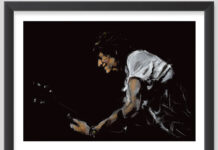
Fender Studio review: a barebones DAW with promise – and teething problems
Fender’s approach to being a guitar company includes having a Fender-branded thing in nearly every stage of the musical creation process. You know, patch cables, pedal power supplies, wireless systems, clocks that look like amplifiers – the essentials. In support of this goal, and following on from the 2021 acquisition of PreSonus, Fender now offers its own DAW – Fender Studio. It’s a barebones, beginner-friendly program that’s available on any platform you like, all for the low, low price of zero dollars. But is it any good?
READ MORE: Walrus Audio Mako Series MkII ACS1 review: “this is as good as digital amp and cab simulators get”
What is Fender Studio?
The fact that it’s a free app that supports mobile platforms ties into Fender Studio’s generally beginner-friendly approach. On top of this, the central selling points are a range of Fender-designed guitar amp sims and effects, and a library of pre-mixed jam tracks you’re free to use in your social media content, or play around with to learn the basics of a DAW.
Being made by many of the same team, there’s a lot of crossover with PreSonus’ Studio One’s UI and feel. There is also a native way to export full projects straight from Fender Studio into .DAWproject files, a relatively new open-source format that’s currently supported by a handful of paid DAWs, including Studio One.
Fender Studio workspace. Image: Cillian Breathnach
What can’t Fender Studio do?
On the surface, Fender Studio seems like an answer to an entry-level (but relatively fully-featured) DAW like GarageBand. In reality, it is even more stripped-back as a proposition – the term DAW suggests MIDI, software instruments and support for third-party plugins, but as of June 2025, Fender Studio doesn’t have any of those. It also only supports a total of 16 audio tracks, which won’t be enough for complex ‘full song’ mixes. It is perhaps more useful to think of it as an elevated voice notes app, and indeed that’s how Fender pitches it – there’s a reason that one of the four options presented upon launch is a big red button that instantly starts recording.
It’s a reasonable approach in theory as, realistically, most beginner guitarists don’t need to get their head around four different Hammond organ VSTs before they start sharing their riffs on Instagram. The pitch is that there’s less of that extraneous stuff but more guitar-friendly features built right in, namely that aforementioned library of amps and effects.
A track in Fender Studio. Image: Cillian Breathnach
In use
But before I get to the guitar sounds on offer, I have to contend with Fender Studio’s UI design. The good news is that there are a lot of elements that are pretty self-explanatory. While I obviously can’t completely Eternal Sunshine my general DAW experience to gauge just how intuitive things really are for beginners, many other visual elements of the program are minimalistic enough to be easy to figure out with a quick bit of experimentation.
With that said, there are a few things I want to call attention to as more than a little obtuse. One thing I have trouble with when I dive in is working out how to pan a track left or right – having not used Studio One before, I’m unaware that the little blue handle below the mute and solo buttons is called the “panner” – so I lose a quarter of an hour fruitlessly searching for a knob somewhere, anywhere, that matches the style of the delay and reverb controls.
Track panner detail. Image: Cillian Breathnach
Having failed to find any way to pan, I search the manual. Searching for “pan” and “panning” doesn’t return any results, and for a moment I ponder if panning has been excluded on purpose. However to find info on the “panner” within the manual you need to type in “panner” explicitly, introducing the fun extra challenge of convincing your autocorrect that you’re not looking through the Fender Studio manual for a hard cheese common in South Asian cooking.
In some ways this shared design language is understandable. But regardless of whether I’m familiar with Studio One, I’d wager that Fender Studio’s target audience of DAW-inexperienced recording beginners aren’t going to intuit things like this. I cannot for the life of me think why this isn’t a big, obvious knob labelled “L/R” or “pan”. It’s also a pretty fiddly control on both desktop and mobile, and has no way to double-click or tap to type in a specific value.
A shortcut to nowhere
Given that the express goal of the software is to get you recording as quickly as possible, it’s not ideal that my next issue crops up as I go to start actually recording. Hitting the ‘R’ key doesn’t, as I am used to from some other DAWs, start rolling. Instead it just toggles whether the selected track is armed to record. That’s fine, but I’m used to ‘R’ as the record key, so I head into the settings menu to change the shortcut…
…and am surprised to find that the settings menu doesn’t really exist, beyond some basic layout tweaks and the audio setup. There’s no way to remap the keyboard shortcuts. This is less than ideal, as the default key to start recording is ‘*’ on the numpad, a key that does not exist on my laptop. So I’m stuck clicking on the record button with my mouse.
This may not sound like a big deal, but dexterity is at a premium in the case of a DAW that’s meant to be used while also holding a guitar. Maybe this is the result of the platform-agnostic, beginner-friendly approach, but changing keyboard shortcuts is hardly power-user hacking. There are a couple of other incompatibilities with the default layout, too – the backspace key does nothing on Mac, for instance. You need to press fn+backspace to delete a region, which turns it into a two-handed operation – again, not ideal when you’re also trying to keep a guitar neck from knocking your coffee over.
Editing in Fender Studio. Image: Cillian Breathnach
Exporting woes
I have one more gripe on the design side of things. Having recorded some stuff I press cmd+S to save my project, and nothing happens. I go to the top window to see where the ‘file>save’ menu is, but it isn’t anywhere, because it doesn’t exist. So where’s my project file being saved? It turns out Fender Studio is autosaving all the time (fine) to a deep system folder (less fine). There is no native way to save full projects to a location of your choosing.
The on-board export function either bounces out audio, or bundles the whole project into a .DAWproject file – but there’s no import function for .DAWproject files. Exporting is a one-way street to the DAWs that currently support the format. As of 2025, that’s Bitwig, Cubase and (all together now) Studio One. To move your project between devices but keep it in Fender Studio, you have to root into Fender Studio’s app folder and bundle up the full project yourself. Not exactly intuitive, and obviously a bit trickier on mobile.
I can only speak to the Android experience; however Apple isn’t particularly forthcoming with users’ deeper app folders, so best of luck to the iPhone users. It takes me some time to find where Fender Studio is saving its projects on my phone’s disk, and once I do, I have to use my phone’s file system UI to zip it and send it to my desktop.
Fender Studio has been explicitly designed for desktop and mobile. Surely the process of moving projects between platforms – and not just exporting out to a ‘full’ DAW – should be built right into it? The mobile app uses the OS share functionality for seamless exporting to a cloud service, or anything that can be shared to – DMs and socials included. So it’s a shame that it’s such a complex operation to move the actual Fender Studio project about.
The sounds
Yes, the UI and UX whinges are finally over. It’s time to talk sounds. Fender Studio’s cabinet of virtual guitar gear includes an overdrive, a fuzz, a chorus, a tremolo, a mono delay, a stereo delay, a hall reverb and a room reverb. The four amps are a ‘59 Bassman, a ‘65 Twin Reverb, a Bassbreaker combo and a Super Sonic. That’s it for the guitar effects block – but you can also load up a separate set of effects for bass and vocals. The bass module keeps the ‘59 Bassman and the majority of the effects, but also adds a bass-specific overdrive, a compressor and a flanger, plus three more bass amp models. There’s a set of vocal effects too, including a de-tuner, a ‘transformer’, a ring mod and a vocoder.
The tonal fidelity on display here is pretty damn good. The effects and amps have been ported over from the GTX series, so despite the superficial resemblance to the Tone Master Pro’s UI, these models aren’t quite as powerful. However, they still do offer some more in-depth controls for further sonic tweaking, such as tube bias and sag.
There’s a lack of touch-responsiveness that means they’re not going to ever make you question owning a real tube amp – but the tones are absolutely release-worthy for the kinds of things you’re going to use a free DAW for. The preset library is pretty broad, too, and demonstrates some creative combinations of effects to hopefully spark some inspiration.
In a very Fender way, the focus remains on the clean and mid-gain sounds, with the occasional preset for blown-out vintage fuzz or indie wobble. I do want to note the rather odd omission of anything geared towards modern metal – the gainiest amp is the Bassbreaker, which has quite a loose, old-school-Marshall voice. Getting a tight, chuggy modern metal sound is all but impossible with the virtual gear here. Given Fender Studio’s self-proclaimed beginner focus, and the current glut of modern heavy bands with huge, young fanbases, this is a bit of a headscratcher. Maybe in a future update…
In a jam
To give the guitar sounds a test within a context, I open one of the jam tracks – these are multi-track recordings that, as well as providing a bed for some noodling, let you experiment with muting/unmuting elements, adding effects to different tracks and doing some rudimentary mixing. Most of them have bass and drums, and then a few rhythm guitar tracks or synth parts depending on the genre of choice.
The quality of the tracks themselves is fine – they’re generic by design, providing a bland musical slate on top of which you can add your own playing. The EULA for these tracks stipulates not to actually release them as full tracks onto, say, Spotify – but you can still jam over them on social media. Fender Studio can also natively time and pitch-stretch the tracks to bring them to your key and tempo of choice, which is a very neat feature. However, since the tracks aren’t software instruments, things can sound a little artefacted the further you stray from the original key/tempo.
Running into limitations
The main issue with having no software instruments, however, is that it’s actually pretty hard to write using Fender Studio. You’re stuck with the deliberately generic parts in the jam tracks – unlike a DAW with even a rudimentary drum sampler, it’s not really capable of letting you actually create a ‘full song’ in the box.
If you’re a bedroom guitarist and you want to write a full song with an original drum pattern, you’re going to need a way to make your own beats in an audio format and then import them in – a hardware drum machine, access to a drummer who can record their own parts, extremely convincing beatboxing skills, that sort of thing. This is a far cry from GarageBand’s auto-drummer, which can instantly provide fairly alright drum parts in-the-box that will at least get you started, and can be edited.
This is a good time to remind ourselves of what Fender Studio ultimately is. When considering it as an elevated voice-memo app, the ‘full DAW’ editing features that like panning, mixing, compression, EQ, reverb and so on do seem a little overwrought – what’s the point of EQing a guitar to sit in a full mix if the software doesn’t have an easy way to create a full mix?
The answer to that is to practice using a ‘full’ DAW without the time and financial investment. Which is ultimately a pretty good thing to exist – a good baseline understanding of DAWs is a pretty good skill for a guitarist, given the prevalence of self-recording in 2025. Fender Studio lets you frog-in-the-water your DAW experience from the very beginning of your playing journey, a good alternative to having to learn a more in-depth program after years of just using a voice notes app.
Final thoughts
So overall, I do really respect the goals of Fender Studio, and I can only knock a free piece of software so much. However, my time with the version of the app as of June 2025 was still a bit of a mixed bag. It really feels like a baseline version of the software at the moment, with things like a more diverse amp lineup and some rudimentary software instruments being potential inclusions in future updates.
Right now, there’s a good bit of fun to be had with the jam tracks and the creative tones – and given that it’s free, I do encourage you to check it out, especially if you’ve not had to get your head around a ‘real’ DAW before. And if Fender Studio doesn’t seem up your street at the moment, as well as noting the obvious alternatives here of BandLab and GarageBand, I’d also like to say that it may well look very different in a year – maybe come back and check out what’s been added in a spell.
The post Fender Studio review: a barebones DAW with promise – and teething problems appeared first on Guitar.com | All Things Guitar.
Source: www.guitar-bass.net












